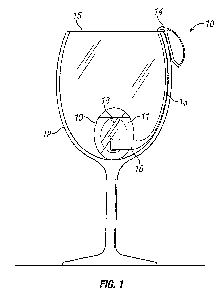Some of the information on this Web page has been provided by external sources. The Government of Canada is not responsible for the accuracy, reliability or currency of the information supplied by external sources. Users wishing to rely upon this information should consult directly with the source of the information. Content provided by external sources is not subject to official languages, privacy and accessibility requirements.
Any discrepancies in the text and image of the Claims and Abstract are due to differing posting times. Text of the Claims and Abstract are posted:
| (12) Patent Application: | (11) CA 2743745 |
|---|---|
| (54) English Title: | A DEVICE FOR RETAINING BEVERAGE COOLING MEANS WITHIN A VESSEL |
| (54) French Title: | DISPOSITIF PERMETTANT DE RETENIR UN MOYEN DE REFROIDISSEMENT DE BOISSON DANS UN RECIPIENT |
| Status: | Deemed Abandoned and Beyond the Period of Reinstatement - Pending Response to Notice of Disregarded Communication |
| (51) International Patent Classification (IPC): |
|
|---|---|
| (72) Inventors : |
|
| (73) Owners : |
|
| (71) Applicants : |
|
| (74) Agent: | BORDEN LADNER GERVAIS LLP |
| (74) Associate agent: | |
| (45) Issued: | |
| (86) PCT Filing Date: | 2008-11-17 |
| (87) Open to Public Inspection: | 2009-05-22 |
| Availability of licence: | N/A |
| Dedicated to the Public: | N/A |
| (25) Language of filing: | English |
| Patent Cooperation Treaty (PCT): | Yes |
|---|---|
| (86) PCT Filing Number: | PCT/GB2008/051073 |
| (87) International Publication Number: | GB2008051073 |
| (85) National Entry: | 2011-05-13 |
| (30) Application Priority Data: | ||||||
|---|---|---|---|---|---|---|
|
A device (10) for retaining beverage cooling means (11) within a vessel (12)
is disclosed. The device comprises a
vessel engaging portion (14) and means (16) for engaging the beverage cooling
means (11), wherein the means (16) for engaging
the beverage cooling means (11) permits the beverage cooling means to move in
sliding relation with respect to the vessel (14)
engaging portion.
Dispositif permettant de retenir un moyen de refroidissement de boisson dans un récipient. Ce dispositif comprend une partie se pinçant sur le bord du récipient et un moyen de prise sur le moyen de refroidissement. Le moyen de prise sur le moyen de refroidissement permet au moyen de refroidissement de coulisser par rapport à la partie pincée sur le récipient.
Note: Claims are shown in the official language in which they were submitted.
Note: Descriptions are shown in the official language in which they were submitted.

2024-08-01:As part of the Next Generation Patents (NGP) transition, the Canadian Patents Database (CPD) now contains a more detailed Event History, which replicates the Event Log of our new back-office solution.
Please note that "Inactive:" events refers to events no longer in use in our new back-office solution.
For a clearer understanding of the status of the application/patent presented on this page, the site Disclaimer , as well as the definitions for Patent , Event History , Maintenance Fee and Payment History should be consulted.
| Description | Date |
|---|---|
| Time Limit for Reversal Expired | 2014-11-18 |
| Application Not Reinstated by Deadline | 2014-11-18 |
| Inactive: Abandon-RFE+Late fee unpaid-Correspondence sent | 2013-11-18 |
| Deemed Abandoned - Failure to Respond to Maintenance Fee Notice | 2013-11-18 |
| Letter Sent | 2012-11-27 |
| Reinstatement Requirements Deemed Compliant for All Abandonment Reasons | 2012-11-16 |
| Deemed Abandoned - Failure to Respond to Maintenance Fee Notice | 2011-11-17 |
| Inactive: Cover page published | 2011-07-18 |
| Inactive: IPC assigned | 2011-07-07 |
| Inactive: Notice - National entry - No RFE | 2011-07-07 |
| Inactive: Inventor deleted | 2011-07-07 |
| Inactive: First IPC assigned | 2011-07-07 |
| Application Received - PCT | 2011-07-07 |
| National Entry Requirements Determined Compliant | 2011-05-13 |
| Application Published (Open to Public Inspection) | 2009-05-22 |
| Abandonment Date | Reason | Reinstatement Date |
|---|---|---|
| 2013-11-18 | ||
| 2011-11-17 |
The last payment was received on 2012-11-16
Note : If the full payment has not been received on or before the date indicated, a further fee may be required which may be one of the following
Patent fees are adjusted on the 1st of January every year. The amounts above are the current amounts if received by December 31 of the current year.
Please refer to the CIPO
Patent Fees
web page to see all current fee amounts.
| Fee Type | Anniversary Year | Due Date | Paid Date |
|---|---|---|---|
| Reinstatement (national entry) | 2011-05-13 | ||
| MF (application, 2nd anniv.) - standard | 02 | 2010-11-17 | 2011-05-13 |
| Basic national fee - standard | 2011-05-13 | ||
| MF (application, 4th anniv.) - standard | 04 | 2012-11-19 | 2012-11-16 |
| Reinstatement | 2012-11-16 | ||
| MF (application, 3rd anniv.) - standard | 03 | 2011-11-17 | 2012-11-16 |
Note: Records showing the ownership history in alphabetical order.
| Current Owners on Record |
|---|
| DAVID DEREK GRANT SPRATLEY |
| Past Owners on Record |
|---|
| None |